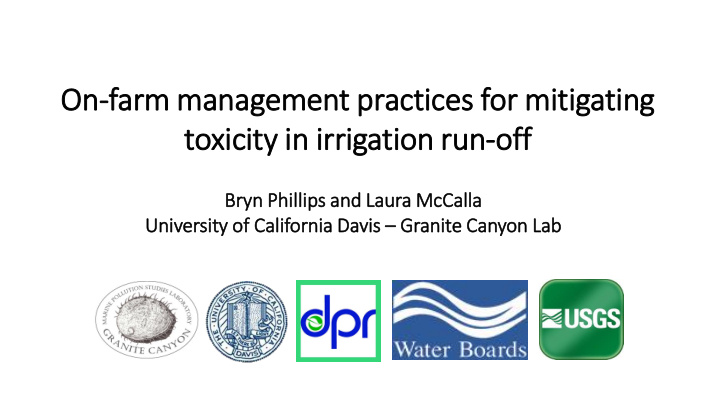



On On-farm management practices for mitigating toxicity in irrigation run-off Bry Bryn Phil illi lips and La Laura McCa Call lla Univ iversit ity of f Ca Cali lifornia ia Davis is – Granit ite Ca Canyon La Lab
Aquatic Toxicity Aquatic toxicity is the aggregate toxic effect of a sample measured directly by an aquatic toxicity test. Aquatic toxicity tests measure biological effects (e.g., survival, growth, reproduction, development). Acute versus Chronic. amphipod crustacean fathead minnow midge fly larva water flea
Solubility & Persistence of f Representative In Insecticides Soil Half Water Half Water Half K oc Chemical Log K ow Life Life Life (mL/g) (aerobic) (photolysis) (hydrolysis) 2 – 15 Weeks – Weeks – DDT 6.0 2,000,000 Years Years Years 7 – 120 21 – 28 35 – 78 Chlorpyrifos 4.7 6,070 Days Days Days 3 – 8 9 – 14 Months – Bifenthrin 6.0 240,000 Months Months Years 104 – 228 <3 33 – 44 Imidacloprid 0.6 132 - 400 Days Hours Days
In Insecticide His istory Changing Use of Insecticides 1950 1960 1970 1980 1990 2000 2010 2020 Organochlorines (e.g., DDT) Organophosphates (e.g., Chlorpyrifos) Pyrethroids (e.g., Bifenthrin) Phenylpyrazoles (e.g., Fipronil) Neonicotinoids (Imidacloprid) fathead minnow midge fly larva water flea amphipod crustacean
Comparative Toxicity Pesti ticid ide 96-Hour Chlorpyrifos Bifenthrin Fipronil Imidacloprid LC5 C50 (n (ng/L /L) Fathead Minnow 122,000 4,850 398,290 ? Water Flea 54 142 17,700 ?? Amphipod 86 9.3 728 65,430 Midge Fly Larva 290 69 32.5 2,650
BMP’s for runoff treatment: Sediment-Bound Insecticides: Retention ponds Vegetated treatment systems Use of Polyacrylamide (PAM) to reduce suspended sediments More Water-Soluble Insecticides: Apply tailwater to non-cropped areas Vegetated treatment systems Enzyme treatment (e.g., Landguard)
Retention Pond
Polyacrylamide (PAM)
Untreated PAM-Treated
Vegetated Treatment System (Pennywort)
BMP Effectiveness – Ponds Two-Pond Study Chemistry Some pyrethroid reductions up to 100% in water Other pesticide reductions 20 - 90% Toxicity 100% mortality to water fleas 100% amphipod mortality at inlet, 72% mortality at outlet Hunt et al. 2008
Vegetated Waterways
BMP Effectiveness – In Integrated Vegetated Dit itch Configuration Sedimentation Basin (100 ft) Vegetated Section (764 ft) Landguard OP-A Treatment (108 ft) Chemistry and Toxicity Organochlorines reduced >90%, pyrethroids up to 100%, chlorpyrifos up to 60% in water Landguard OP-A enzyme removed diazinon 88% average water flea survival after Landguard OP-A treatment Anderson et al. 2009, 2011
BMP Effectiveness – In Integrated Vegetated Dit itch Adjustable volume and retention time, pennywort and grass vegetation, Landguard Organochlorines reduced up to 100%, some pyrethroids up to 100% in water Organophosphate concentrations & toxicity removed Anderson et al. 2011, Phillips et al. 2012,
BMP Effectiveness – In Integrated Vegetated Dit itch Organophosphate mitigation tested with simulated chlorpyrifos-spiked irrigation Two simulated flow rates: 50 gpm and 100 gpm Vegetated with native grass (red fescue), and include installations of compost and granulated activated carbon in mesh enclosures Chlorpyrifos load reduced by 98% at low flow, 94% at high flow GAC in vegetated ditch removed additional 4-8%, depending on flow Phillips et al. 2017
Vegetated System – Concerns Food Safety Mammal presence (pathogen vectors) Vegetation choice & fencing Cost & Maintenance Ditch Construction - ~$10,100 (grading, seeding, irrigating, & maintaining) Carbon – New GAC and disposal: $350-550 for two 55-gallon drums Bulk ~$1-2 per pound Mesh filter material: ~$100 per 130 ft roll
Pennywort GAC
Aerial Vie iews
Summary: On-Farm Management Retention Pond Polyacrylamide (PAM) Integrated vegetative treatment system Sedimentation basin Vegetated ditch Polishing step: GAC (or Biochar?) Enzyme treatment
Recommend
More recommend